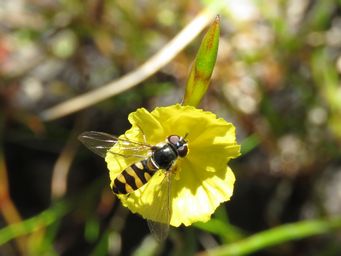Australia So Much to See







Philotheca brucei subsp. brucei 2013 (formerly Eriostemon brucei subsp. brucei), Bruce's Waxflower, Small-leaf Waxflower. There
are three subspecies of Philotheca brucei.
Pink of white five petalled flowers on a shrub which can reach two metres in height. Ten
upright stamens encircling the ovary. Narrow alternating leaves are up to 1.5 centimetres long and warty. Stems and leaves
are covered in bumps (warty).
August
Philotheca sericea 2013 (formerly Eriostemon sericeus).
White or pink five petalled flowers with petals covered with short fine
hairs, and ten stamens also covered in hairs, with orange anthers which encase the ovary. Stigma is pink. Small alternating
concave leaves which widen to a rounded tip. Leaves have slight bumps. Shrubs can reach two metres in height.
Photo at
right is fading, but it shows the hairiness.
August
Latham and Pindar, Mid West region, Western Australia. Found through the
Mid West and into the northern Wheatbelt region.


Philydrella pygmaea subsp. pygmaea, Butterfly Flower.
A tiny yellow flower which has two large petals, one pointing up and a larger
one pointed down. These are fine and delicate and have wavy edges. The other four petals are too small to notice. Flower centre has a single stamen and an ovary. Foliage consists of one or two long very fine cylindrical leaves coming from
the ground, curving inward longitudinally, and terminating in a point.
October November
Phyllangium divergens 1996, Wire Mitrewort.
Tiny white four petalled tubular flowers two millimetres across in a loose cluster
from a pair of leaves. Flower tube s within a green fused calyx, with two points. Branching stems are from a similar pair
of leaves. Stems are slender and reddish brown, with several growing from a small rosette of four rusty coloured leaves at ground
level. May reach ten centimetres long, upright or sprawling.
November



Philotheca tomentella 2013 (formerly Eriostemon tomentellus), Wooly Waxflower, Grey Waxflower.
Pink and white five petalled flowers
with some hairiness on petals and stamens. Rear of flowers and buds have pink striping. Anthers are orange, and stamens
encase the ovary. Short cylindrical leaves are opposite, and have a blue/grey appearance from their hairiness, and together
with the stems are bumpy (warty).
August
Westonia in the Wheatbelt region, Western Australia, and found in the Mid
West, Wheatbelt and Goldfields regions.
